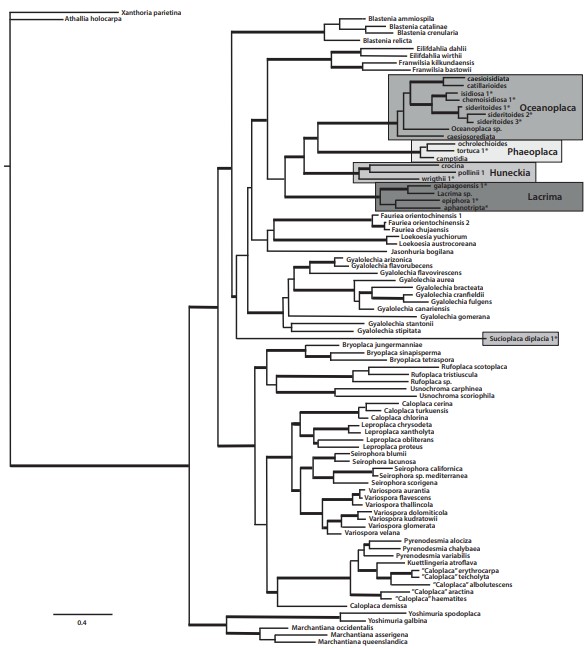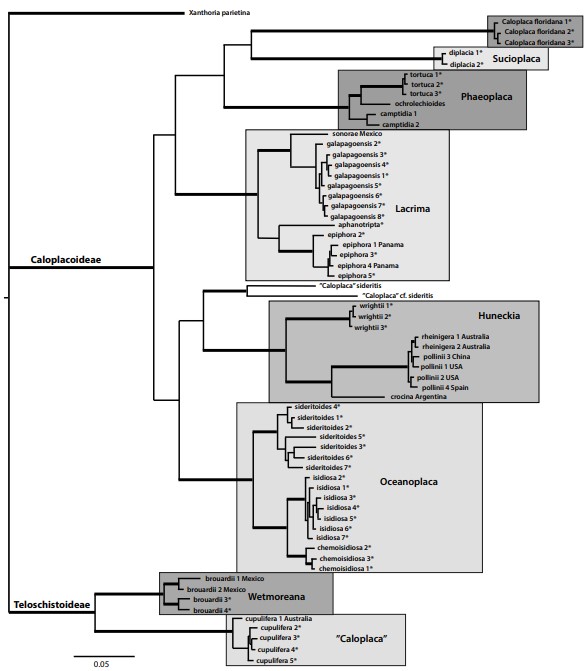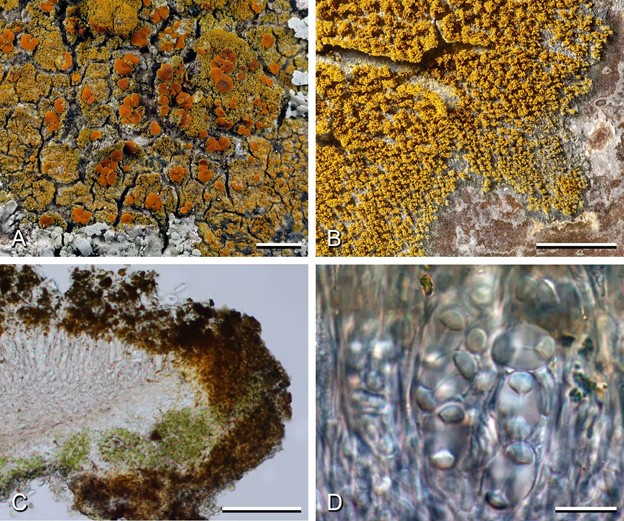Lacrima epiphora (Taylor) Bungartz, Søchting & Arup, comb. nov. (Figs 1–2, 8A–D)
MycoBank number: MB 836939; Index Fungorum number: IF 836939; Facesoffungi number: FoF 13607;
Basionym: Lecanora epiphora Taylor, London J. Bot. 6:159. 1847; MycoBank MB 388181.
Description. Thallus thin and poorly developed as a waxy, continuous to rimose layer, developing from a smooth blackish hypothallus, not distinctly delimited, effuse; surface yellow-orange, smooth, ± shiny, epruinose, very densely covered by small, granular to ±coralloid isidia, ~50 µm thick. Apothecia typically scarce and fre- quently absent, dispersed to loosely aggregated, occa- sionally deforming one another, sessile, up to 1 mm in diam., lecanorine to indistinctly ‘zeorine’ (e.g., the proper margin can occasionally be distinguished as an additional, non-isidiate rim); thalline margin concolorous with the thallus, with age almost entirely dissolved into granular or even ± cylindrical isidia, regularly to irregularly circular in outline, pale yellow to orange, epruinose, C−, K−; proper margin typically ill-defined, deep orange to ferruginous, concolorous with the disc, epruinose, C−, K−; disc flat to slightly convex, deep orange to ferruginous, densely covered by coarse orange pruina, C− (±weakly red, indistinct), K+ purple; epihymenium with orange pig- ment granules, C− (±orange red intensifying), K+ purple, contiguous with the outer exciple; hymenium hyaline, not inspersed; proper exciple extending laterally from the colorless hypothecium as a ± distinct hyaline layer, apically with orange pigment granules, C− (±orange red intensifying), K+ purple, thalline exciple differentiated into an inner part abundantly filled with trebouxioid pho- tobionts and occasionally few, small, colorless crystals, dissolving in K, and an outer part that with age laterally disintegrates; subhymenium thick, well developed, very pale brown, of intricately interwoven hyphae, structur- ally distinct from the narrow, hyaline hypothecium of more parallel hyphae, both not inspersed; asci clavate, Teloschistes-type; ascospores 8/ascus, polaribilocular, narrowly to broadly ellipsoid (9.7–)11.4–16.0(–20.1) × (5.8–)6.9–8.6(–9.2) µm, with a thick, (3.5–)4.4–7.3(–9.4) µm wide septum (n = 46). Pycnidia not observed (in the Galapagos material).
Chemistry. Thallus and apothecia P–, K+ purple, C–, KC–, UV– (dull); with a large proportion of fragilin and a smaller proportion of parietin; additionally chlorinated accessory metabolites such as 7-chloroemodin and 7-chloroemodic acid are occasionally also detected.
Ecology and distribution. Lacrima epiphora occurs in neotropical regions of North, Central and South America (see Wetmore, 2004). In Galapagos, it is one of the most common corticolous species, rarely also occurring on wood or rock, and common throughout the dry zone and lower transition zone, occasionally also in upper transition zone, rarely in the humid zone. It is particularly common on Bursera and Erythrina, typically in wind- and rain-ex- posed, but often ± shaded habitats.
Notes. Lacrima epiphora is characterized by a densely isidiate, yellow-orange thallus, a relatively pale color due to the high content of fragilin. In Galapagos, according to the ITS sequences obtained here, the species appears closely related to L. galapagoensis and L. aphanotripta (Fig. 2). Weber (1986) originally reported it as Caloplaca byrsonimae (Malme) Zahlbr.

Figure 1. Three-gene tree (nrITS, nrLSU and mrSSU) of the subfamily Caloplacoideae, with the species reported from the Galapagos highlighted. Nodes supported by posterior probabilities higher than 0.95 are in bold. Sequences generated from Galapagos material are marked by an asterisk*.

Figure 2. Phylogenetic nrITS tree of species from the subfamily Caloplacoideae and Teloschistoideae in the Galapagos, emphasizing the relationship of the newly described genera Lacrima, Oceanoplaca, Phaeoplaca, and Sucioplaca. Nodes supported by posterior probabilities higher than 0.95 are in bold. Sequences generated from Galapagos material are marked by an asterisk*.

Figure 8. Lacrima epiphora. A – abundantly isidiate, yellow-orange thallus with deep orange apothecia (Bungartz, F. 5714, CDS 33352); B – thallus almost entirely composed of isidia on a white to blackened membranaceous hypothallus (Bungartz, F. 6315, CDS 34530); C – apothecial section: lecanorine, outer thalline exciple and epihymenium brownish orange, inner thalline exciple abundantly filled with trebouxioid green algae, hypothecium hyaline, laterally extending into inner, proper exciple, apically orange brown [not in DIC, in water] (Aptroot, A. 64755, CDS 31330); D – asci with broadly ellipsoid ascospores, septum broad [DIC, in water] (Nugra, F. 590, CDS 38968). Scales: A–B = 2 mm; C = 100 µm; D = 10 µm.
